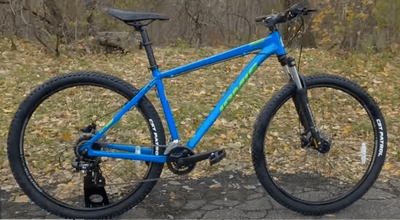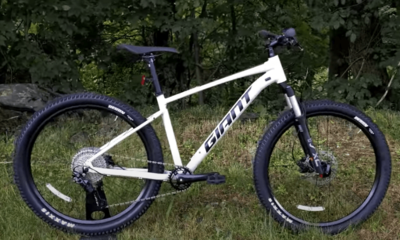Many riders want to know which is better Jamis or Giant mountain bikes. I see this a lot in bike forums. They are looking for a comparison between Jamis vs Giant mountain bike bicycles.
Most people think Giant is better because it is well known and a big company, but Jamis has improved a lot since they began making mountain bikes. Let’s take a look below then you will be able to make the best decision for you.
Jamis vs Giant Mountain Bike (History)
Jamis Bikes was founded by Ron Jamis in 1979 in Florida. At that time he launched one of the first beach cruiser bikes. During the 1980’s he released many cuisers and mountain bikes.
During the late 1980’s road bikes were produced and launched as well as hybrid style bikes. Then in the 1990’s they expanded into the competitive mountain bike market by producing hardtail and full suspension bikes with advanced shocks and drivetrains.
Soon after Jamis Bikes was bought by a well known and established US bicycle maker. They started to build their bikes at a larger scale in Taiwan and China. This allowed them to save money and really focus. They focused on mountain bikes and in 1993 released the hardtail Dragon mountain bike.
The is the mountain bike that made Jamis more famous. This Dragon was equipped with RockShox suspension and a drivetrain that was a 24 speed Shimano XTR. Plus it had fillet-welded Tange Prestige tubing.
By the 2000’s Jamis because even more well known for mountain biking. Two of their bikes the Dakar Comp and the Dakar XLT won Bike of the Year and Best All-Mountain Bike awards from mountain biking magazines.
During the late 2000’s Jamis was one of the first companies to start using 650B wheel size before it became universal standard in mountain biking. They also released full carbon mountain bikes like the Zenith T-series which broke many records in time trials.
From 2001 to 2005 Jamis won many awards for suspension bikes given to them by famous mountain bike magazines. Since then their suspension technology has improved further which I will explain later.
Giant Bikes History
Giant Bicycles was founded in 1972 in Taiwan by King Liu and Tony Lo. King is an expert in bike manufacturing so the company begins by making bikes for the world’s top brands.
One of the brands Giant manufactured bikes for was the US based Schwinn Bike Company. Making bicycles for many brands helped Giant become an industry leader.
Schwinn eventually broke away from Giant so they could manufacture bikes cheaper in China. So in 1987 Giant started to make their own brand of bikes.
Giant is able to manufacture bikes in 50% of the time it takes to make them in the US. Because Giant is in Taiwan the suppliers and OEM companies are near to each other. Acquiring the materials, design, and manufacturing does not take much time. Giant can control the entire process in-house which results in a higher quality product.
In 1987 Giant became the first bike maker to use computers for design and volume production techniques in order to make carbon fiber road bikes. It was called the Cadex carbon fiber road bike.
In 1995 Giant started to make mountain bikes as compared to Jamis which started in 1993. Giant sponsored it first World Cup mountain bike team. American racer John Tomac and Norwegian cross country mountain biker Rune Hoydahl were part of the team and became famous.
In 2004 Giant releases its advanced Maestro suspension technology. It is specifically designed for off-road mountain biking. This suspension has four pivot points which neutralize pedaling and braking forces creating a smoother more efficient ride. The suspension remains fully active on all types of terrain.
From 2007 to 2010 Giant won an award each year for four consecutive years. They won the Eurobike award, which is recognized by the International Forum Design organization for innovative designs.
27.5 inch wheels have become very popular. Giant was the first large manufacturer to produce a full lineup of mountain bikes using 27.5 inch wheel technology.
Jamis and Giant Suspension Technology
Suspension technology is very important for a mountain bike because it enables the bike and the rider to have a smooth efficient ride and be able to absorb and redirect bumps on the trail. Today both Jamis and Giant have advanced suspension technology which you should know about.
Jamis 3VO
3VO stands for 3 variable optimized. There are 3 parts to this suspension system which are Instant Center, Axle Path, and Leverage Ratio. These three work together no matter which kind of trail you are on, or how much travel your mtb has, or what kind of shock you are using.
You don’t have to tune the Portal and Hardline’s 3VO suspension for a particular riding style. You can ride up hill of down hill or go on technical trails as well as on cross country.
Instant Center
The Instant Center has special virtual pivot features that allow it to bring together the efficiency of a hardtail with the support of an accurate active suspension.
As you pedal there will be no loss of pedal energy because of suspension movement. Your pedaling will be most efficient no matter what the rider output is, the wheel travel, the terrain, or the gear combination.
You will be able to absorb small bumps easily because the design stays active and supple. This happens because the drive forces are directed into and through the center of the virtual pivot at all points in the travel.
It does not matter what gear you are in, the kind of damping of your rear shock, or how much sag you like because the pivot location made by the 3VO design works regardless of these factors.
Even when you are braking strongly the suspension continues to be very active and responsive. To maintain stability there are high anti-rise to counteract forward weight shifts.
Axle Path
When you are riding on rough terrain it is important that the rear wheel stay planted and in contact with the ground. The rearward axle path allows this to happen so the mountain bike is supple on small bumps and square edge hits. The suspension remains highly reactive because of the systems leverage ratio even when pedaling.
You get additional pedaling stability because the rearmost position of the axle is located a little beyond the most common sag point.
For the amount of travel on your bike you get maximum tire clearance because after the first rearward motion the axle moves forward at a rate optimized for the tire clearance. You will not feel any pedal kickback at the pedals.
The axle path will give your bike increased small bump absorption as well as enable you to handle larger impacts easily. This is because the first rearward motion and then a forward motion creates an axle path that is overall vertical.
Leverage Ratio
With the correct leverage ratio you will be able to handle repeated bumps without stopping. This is because of the tuned multi-phase leverage ratio with its initial rising rate. The system uses a slight rising rate up to a little beyond the sag point.
It is at this position because up until the sag point of the mountain bike sensitivity and responsiveness are mainly felt when the suspension can extend, not compress.
The initial falling rate is usually always less energy efficient and responsive than an initial rising rate.
After the first rising rate, next the system uses a little falling rate. Together with the anti-squat and reactive instant center position, this leverage rate enables the bike to have maximum pedal speed and be sensitive to impacts from bumps, while also cushioning heavy impacts.
Giant Flexpoint Suspension Technology
Flexpoint suspension technology creates a lightweight, durable suspension system which has 120mm of rear travel. It does this by the flexing action of the chainstay and seatstay junction which uses a single pivot design.
Flexpoint Suspension gets rid of complicated pivots and linkages to ensure a reliable lightweight and durable suspension system that is simple to maintain. This is accomplished by using the flexing mechanisms of the rear chainstay and seatstay.
You will have additional control for more reliable mountain bike riding because of its proven single pivot suspension design.
The suspension system is lightweight and durable, plus it offers 120mm of rear wheel travel because of the flexing action of the chainstay and seatstay intersection.
You won’t need to pay for added costs or have any need for frequent maintenance because Flexpoint has the same benfits as multi-link suspension systems.
FlexPoint Pro Suspension
Flexpoint Pro gives the mountain bike 100mm of rear wheel travel by using a linkage driven, single pivot system. It has been designed with a full composite swingarm which makes the overall frame weight much lighter.
The bike is more efficient, has greater traction and control for mountain bike trails because of its proven linkage driven, single pivot suspension configuration. Handling steep climbs and fast technical down hill rides is much easier.
The Flexpoint Pro design reduces the weight of the bike compared to dual-rocker designs. This is because they have taken away the lower rocker arm and 2 pivot points. Plus advanced full composite construction is used making the entire system lighter.
As you can see both Jamis and Giant mountain bike suspension technology are advanced and highly effective. They both create a smoother more efficient ride while still being able to handle all the different types of terrain you will ride over.
Jamis Durango 2021 vs Giant Talon One 2021

The Jamis Durango is a beginner level hardtail mountain bike. The frame is made of 6061 t6 aluminum. It has a pretty nice shape. The geometry is designed with a 69 degree head tube angle and a 74 degree seat tube angle.
The chainstay on this bike is 450 millimeters which will make the bike handle very well as a great all around bike as well as a mountain bike. The fork on the front is an sr suntour xce28 which is a coil spring fork with 28 millimeter stanchions.
It is very easy to take off and put on the wheels because the spacing on the bike is a standard quick release for both wheels. The wheels are alex td 26 rims. They are 32 holes double walled and run 14 gauge spokes down to six bolt hubs.
The drivetrain is a 2 by which means it runs 2 rings up front 8 gears in the rear. It runs a Shimano tourney tx rear derailleur which has a shimano hg-31 cassette with an 11 to 32 range. Then up front there are forged alloy arms on a square taper bottom bracket.
The bottom bracket is threaded into the frame with an altus front derailleur. So the drive train will give you lots of range on all types of terrain.
There are combo integrated shift and brake levers which is great for packaging which keeps everything compact. Though some riders may prefer the shifter and the brakes to be separate just in case one gets damaged so you don’t need to replace both.
The Jamis Durango has a little more advanced geometry and a good reach to it. The tube shaping is pretty cool as it has very angular style shapes. It has external cable routing which they do a very nice job of tucking it under the top tube.
Giant Talon One 2021

The Giant Talon One is the top end version of the Talon series. It is a great ride for mountain biking on any kind of terrain. It is made of an aluminum frame with manipulated tubing. The routing of the cable system is internal so it has a nice sleek look.
This version of the Talon is 27.5 inches, so it has a seat tube angle of 74 inches. The front end has a slacker 67 and a half degree headtube angle. The chainstay length is 440 millimeters. These numbers make the 27.5 inch bicycle a more playful mountain bike. This is great for riders who want to get up off the ground with their bike.
The bar is a 31.8 alloy handlebar which is nice and wide. There is also a 31.8 stem which is 60 millimeters in length. Its quad bolt faceplate makes a nice set up with its big grips. The grips feel very nice even though they are not lock on.
The seat on the bike is a Giant saddle which is mounted on a 30.9 rigid aluminum post. It has a quick release adjustment so you can open it in order to raise and lower the seat without using any tools.
This mountain bike has a 10-speed version of Shimano’s drivetrain. It is reliable and shifts very well. The derailleur is clutched so you have a lever which allows you to turn on the clutch which keeps the chain from bouncing around and making contact with the chainstay.
This derailleur handles the chain over an 11 to 42 range on the back end. It is a shimano cassette 11 to 42 which is a nice set up. Then in front there is a 1 by crank set. It uses aluminum arms and a threaded bottom bracket.
There is a 32 tooth chainring which is very good for sport mountain biking. You can do lots of climbing. Especially with its Giant gx03v rims, they are aluminum double walled rims which run 32 spokes in the front and the back.
The spokes are connected to six bolt Giant sport tracker hubs. The hubs in the front are 9 by 100 and in the back they are 9 by 135. The Giant Recon tires are 27.5 by 2.4. It is a faster rolling tire and has some good side knobs.
As you can see both the Jamis and Giant mountain bike are high quality bikes. The makers have years of experience in design and quality.
They both use advanced technology for their suspension system as we saw earlier.
That being said it is up to you to decide which brand is right for you. I would ride both brand of mountain bike and see how they feel and fit for you. Have fun.
